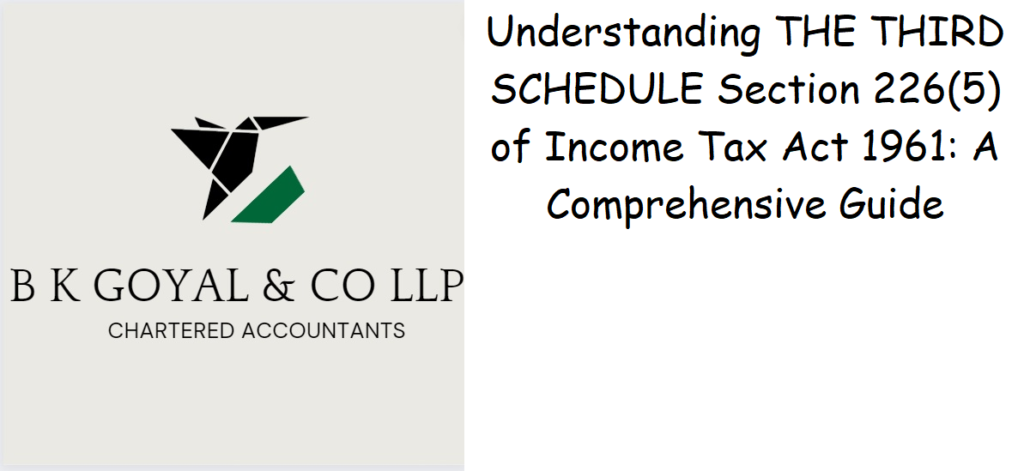Introduction
Are you looking to understand about Understanding THE THIRD SCHEDULE Section 226(5) of Income Tax Act 1961: A Comprehensive Guide ?
This detailed article will tell you all about Understanding THE THIRD SCHEDULE Section 226(5) of Income Tax Act 1961: A Comprehensive Guide.
Hi, my name is Shruti Goyal, I have been working in the field of Income Tax since 2011. I have a vast experience of filing income tax returns, accounting, tax advisory, tax consultancy, income tax provisions and tax planning.
Taxation is an essential aspect of any country’s economy. In India, the Income Tax Act 1961 governs the taxation system, and THE THIRD SCHEDULE section 226(5) is a crucial provision of the Act. This section is related to the deduction of tax at the source, and it has far-reaching implications for both taxpayers and employers.
In this blog, we’ll provide a comprehensive guide to help you understand THE THIRD SCHEDULE section 226(5) of the Income Tax Act 1961. We’ll cover what it means, its significance, how it works, and answer some frequently asked questions.
Understanding THE THIRD SCHEDULE Section 226(5) of Income Tax Act 1961
THE THIRD SCHEDULE section 226(5) of the Income Tax Act 1961 deals with the deduction of tax at the source. It states that when an employer makes any payment of salary or wages to an employee, they must deduct the appropriate amount of tax at the source and deposit it with the government.
The section also provides guidelines on how to calculate the appropriate amount of tax to be deducted. The employer needs to consider the employee’s income, deductions, and exemptions before deducting tax. The rate of tax deduction depends on the employee’s income and the applicable tax slab.
The main objective of this section is to ensure that taxpayers pay their taxes in a timely and efficient manner. By deducting the tax at the source, the government ensures that taxpayers don’t default on their tax payments. This provision also helps taxpayers to plan their taxes better as they can estimate their tax liability for the year based on their income.
How does THE THIRD SCHEDULE section 226(5) work?
To understand how THE THIRD SCHEDULE section 226(5) works, let’s consider an example. Suppose you’re an employee earning a salary of Rs. 50,000 per month. Your employer deducts TDS (tax deducted at source) of Rs. 5,000 per month and deposits it with the government.
At the end of the financial year, when you file your income tax return, you’ll get credit for the TDS deducted by your employer. The TDS amount is adjusted against your total tax liability for the year. If the TDS amount is higher than your tax liability, you’ll get a refund from the government. If the TDS amount is lower than your tax liability, you’ll have to pay the remaining tax amount to the government.
It’s important to note that THE THIRD SCHEDULE section 226(5) applies to all employees, including salaried individuals, freelancers, and consultants. Employers are required to deduct TDS on all payments made to their employees, including salary, bonus, commission, and other allowances.
Frequently Asked Questions
Q: What happens if the employer fails to deduct TDS under THE THIRD SCHEDULE section 226(5)? A: If the employer fails to deduct TDS, they’ll be liable to pay interest and penalty. The employee can also be penalized for non-payment of taxes.
Q: Can an employee claim a refund if the employer deducts excess TDS? A: Yes, the employee can claim a refund of the excess TDS by filing their income tax return.
Q: Is it mandatory for all employers to deduct TDS under THE THIRD SCHEDULE
section 226(5) of the Income Tax Act 1961?
A: Yes, it’s mandatory for all employers to deduct TDS under THE THIRD SCHEDULE section 226(5) of the Income Tax Act 1961. Failure to do so can result in penalties and legal action.
Q: How can an employee ensure that the correct amount of TDS is deducted by the employer? A: An employee can ensure that the correct amount of TDS is deducted by providing accurate information about their income, deductions, and exemptions to their employer. They can also check their Form 26AS to verify the TDS amount deducted by the employer.
Conclusion
In conclusion, THE THIRD SCHEDULE section 226(5) of the Income Tax Act 1961 is a critical provision that ensures timely tax payments by taxpayers in India. It’s mandatory for all employers to deduct TDS from their employees’ salaries and deposit it with the government. This provision helps taxpayers to plan their taxes better and avoid defaulting on their tax payments.
Employers must ensure that they deduct the correct amount of TDS based on their employees’ income, deductions, and exemptions. Failure to do so can result in penalties and legal action. As a taxpayer, it’s essential to understand your tax liability and file your income tax return in a timely and accurate manner.
We hope that this comprehensive guide has helped you understand THE THIRD SCHEDULE section 226(5) of the Income Tax Act 1961. If you have any further questions or need assistance with your taxes, consult a tax professional or visit the Income Tax Department website.
THE THIRD SCHEDULE section 226(5), of Income Tax Act, 1961
THE THIRD SCHEDULE section 226(5), of Income Tax Act, 1961 states that
Distraint and sale.
Where any distraint and sale of movable property are to be effected by any Assessing Officer or Tax Recovery Officer authorised for the purpose, such distraint and sale shall be made, as far as may be, in the same manner as attachment and sale of any movable property attachable by actual seizure, and the provisions of the Second Schedule relating to attachment and sale shall, so far as may be, apply in respect of such distraint and sale.
